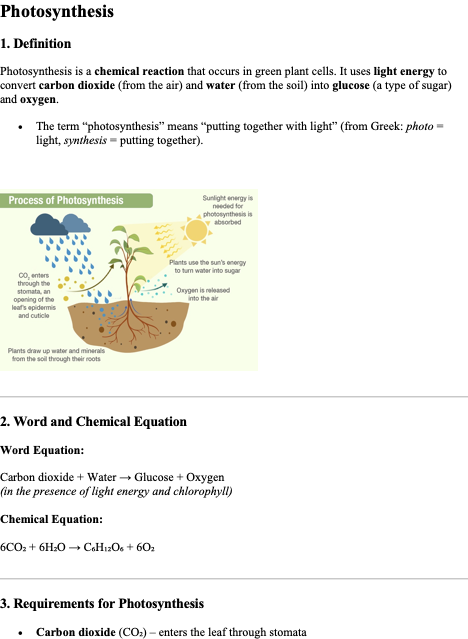Photosynthesis and Ecology
Photosynthesis
1. Definition
Photosynthesis is a chemical reaction that occurs in green plant cells. It uses light energy to convert carbon dioxide (from the air) and water (from the soil) into glucose (a type of sugar) and oxygen.
The term “photosynthesis” means “putting together with light” (from Greek: photo = light, synthesis = putting together).
2. Word and Chemical Equation
Word Equation:
Carbon dioxide + Water → Glucose + Oxygen
(in the presence of light energy and chlorophyll)
Chemical Equation:
6CO₂ + 6H₂O → C₆H₁₂O₆ + 6O₂
3. Requirements for Photosynthesis
Carbon dioxide (CO₂) – enters the leaf through stomata
Water (H₂O) – absorbed from the soil by roots
Sunlight – provides energy for the reaction
Chlorophyll – green pigment in chloroplasts that captures light energy
4. Where It Happens
Photosynthesis takes place in chloroplasts in the cells of green plants.
Chlorophyll, found in chloroplasts, absorbs sunlight to start the reaction.
5. Products of Photosynthesis
Glucose (C₆H₁₂O₆): Used as energy, stored as starch, or converted into other substances.
Oxygen (O₂): Released as a waste product into the air.
6. Structure of a Leaf and Adaptations for Photosynthesis
Wide and flat: Increases surface area to absorb more light.
Thin: Allows gases to reach cells quickly.
Stomata: Tiny pores for gas exchange.
Veins: Transport water to the leaf and glucose away
Chlorophyll: Absorbs sunlight efficiently.
7. Factors Affecting the Rate of Photosynthesis
Light intensity: More light increases the rate until it levels off or causes damage.
Carbon dioxide concentration: Higher levels increase the rate up to a certain point.
Temperature: Moderate warmth increases the rate, but too much heat destroys enzymes and stops the reaction.
8. Uses of Glucose in Plants
Energy: Broken down in respiration.
Stored as starch: Starch is insoluble and less reactive, ideal for storage.
Making other substances:
Proteins (needs nitrogen from soil)
Fats and oils
Sucrose: For transport
Cellulose: For cell walls
Chlorophyll
9. Testing for Starch (to prove photosynthesis happened)
Step 1: Boil the leaf in water to break cell membranes (2 minutes) .
Step 2: Remove chlorophyll using alcohol (2 minutes).
Step 3: Add iodine solution:
Blue-black = starch present (positive test)
Orange-brown = no starch (negative test)
Ecology
Key Definitions
Species: A group of organisms that can reproduce with each other and have fertile offspring.
Population: A group of the same species living in the same place at the same time.
Community: Different populations living and interacting in one area.
Habitat: The natural place where an organism lives.
Ecosystem: A community of living things and the non-living things in their environment (such as air, water, and soil).
Ecology: The study of how living things interact with each other and with their environment.
Relationships Between Species and Environments
A population is made of individuals of one species.
A community is made of many populations living together.
An ecosystem includes both the community and the non-living parts of the environment.
A change in one population often shows a change in the ecosystem.
Feeding Types
Producers: Make their own food using sunlight (plants, some bacteria).
Consumers: Eat other organisms because they cannot make their own food.
Herbivores: Eat only plants.
Carnivores: Eat only animals.
Omnivores: Eat both plants and animals.
Feeding Types (with Examples)
Producers: Make their own food using sunlight (photosynthesis) or chemicals.
Examples: Grass, seaweed, algae, oak trees, cyanobacteria.Consumers: Cannot make their own food. They must eat other organisms.
Herbivores: Eat only producers (plants).
Examples: Cow, deer, rabbit, caterpillar.Carnivores: Eat only other consumers (animals).
Examples: Lion, fox, hawk, spider.Omnivores: Eat both producers and consumers (plants and animals).
Examples: Humans, bears, raccoons, chickens.
Food Chains
A food chain shows how energy moves from one organism to another.
It always starts with a producer.
Example: Leaf → Caterpillar → Bird → Fox
Each arrow means "is eaten by".
Consumer Levels in a Food Chain
Producer: Makes its own food.
Primary consumer: Eats the producer (usually a herbivore).
Secondary consumer: Eats the primary consumer (usually a carnivore).
Tertiary consumer: Eats the secondary consumer.
Food Webs
A food web shows how multiple food chains are connected.
Most animals are part of many food chains.
Having more than one food source makes animals more likely to survive.
Interdependence and Changes
All species in a food chain or web depend on each other.
If one species decreases or dies out, it can affect many others.
Example: If grass dies, rabbits will starve, and foxes that eat rabbits will also decrease.
Predator and Prey
Predator: Hunts and eats other animals.
Prey: The animal that is eaten.
Prey animals have adaptations like camouflage or toxins to protect themselves.
Predator-Prey Cycles
Predator and prey populations rise and fall in cycles.
Example: More rabbits → more foxes. Fewer rabbits → fewer foxes later.
These cycles affect the entire food web.
